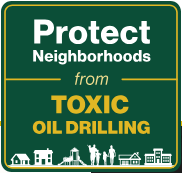Ohio Lawmakers Approve New Oil and Gas Well Regulations
June 4, 2012Press Release – NY City Council Speaker Quinn is Asked for Hearings on Radon in Marcellus Gas Coming to NYC
June 5, 2012Letter to NY City Council Re: Joint Hearings on Radon in Natural Gas from the Marcellus Shale
 Click HERE to read the letter as delivered on June 4.
Click HERE to read the letter as delivered on June 4.
Read the Press Release here.
For additional information:
NY groups: Radon in Marcellus gas could jeopardize public health
Radioactive elements in Marcellus gas warrant new study
The Honorable Christine C. Quinn
Speaker, City Council of New York
250 Broadway, Room 185
New York, NY 10007 June 1st, 2012
Re: Committee on the Environment and Committee on Health
Joint Hearings on Radon in Natural Gas from the Marcellus Shale
Dear Speaker Quinn;
We are writing to request your assistance in holding joint hearings of the Committee on Environmental Protection and the Committee on Health as soon as possible on an environmental issue with very serious potential public health implications. As the proposals for the pipelines that will transport Marcellus shale gas to the New York area have come under public scrutiny, it has become apparent that the official government reviews have ignored one critical issue, the potential for exposing every New York household that uses natural gas to dangerous levels of radioactive radon. Until now, the issue of radon pollution in natural gas has been ignored in environmental impact documents and further brushed aside by the FERC in its public hearing processes.
There is every indication that Marcellus shale gas could become the predominant source of natural gas supplied to residential, commercial and industrial users in the New York City metropolitan area. Consolidated Edison, with support from the Mayor’s office, is actively promoting greater use of natural gas from the Marcellus shale area in response to the City’s determination to require a switch in building fuels from highly polluting number six fuel oil.
Switching from Number 6 oil was a highly welcome step. Unfortunately, neither Con Ed, nor FERC, nor the City appear to have considered whether by promoting a switch to gas that will most likely come from the Marcellus area, they may be substituting a more serious pollution problem for the ones they are attempting to solve with this fuel switch.
Currently, this must be treated as a potential threat. There is a lack of definitive information in the public documents as to when, from where and how Marcellus shale gas will be brought into the City via various pipelines including the new Spectra pipeline to run from Linden, NJ, to Manhattan. However, there is every reason to believe that the Marcellus shale area may become the principal source of natural gas to the metropolitan area. Recent articles in the industry press have stressed the economic incentive with high cost fracked gas to minimize transmission costs by distributing the gas locally to the closest available major market. The new and upgraded pipelines in the Marcellus area now under consideration or construction are intended to collect gas from the Marcellus shale area and to bring it to the New York metropolitan area.
The consequences of introducing Marcellus shale gas into domestic natural gas markets in New York City could create a public health emergency, the potential for which neither the current City Administration nor Con Ed is taking seriously. It is the absence of such a systematic evaluation of whether Marcellus shale gas will be distributed in New York City and the lack of any formal assessment of the public health risks of doing so that has led us to turn to the Council for leadership and support on this issue.
The basic science is straight forward. All natural gas produced from deep shale contains radon. Radon gas is highly carcinogenic and cannot be destroyed except by the process of radioactive decay. The United States Environmental Protection Agency has determined that exposure to radon is the leading cause of lung cancer among non-smokers, accounting for 21,000 fatalities per year on a nationwide basis. Exposure to the radon and its radioactive progeny from Marcellus natural gas could lead to thousands of additional cancer deaths in New York. Among the radioactive progeny are two radioactive solids, polonium and lead, that will stay in the lungs once inhaled or created when radon decays while inside the lung. Polonium decays by emitting high energy alpha particles that damage cellular DNA and create cancer cells. The radioactive lead decays by beta particle emission to create more radioactive polonium.
The reason for our concern is as follows. Most of the natural gas currently consumed in the New York metropolitan area comes from the Gulf Coast where the natural occurring level of radon at the well head is low, about 5 picocuries per liter. Moreover, it takes about six to eight days for the Gulf Coast gas to reach the New York area. The natural half-life of radon is 3.8 days (“half-life” is a physics concept that states how long it will take the process of radioactive decay to reduce the amount of radioactive material in half). This means that in the time it currently takes natural gas to reach New York, the radon level in the gas will decrease from about 5 picocuries per liter to about 1 picocurie per liter. While there is no “safe” level for exposure to ionizing radiation, EPA recommends taking mitigation measures if the radon level in a residence reaches 2 pciocuries per liter or more. Consequently, current radon exposure levels across the metropolitan area are well below the EPA recommended action level.
Introduction of Marcellus shale gas into the New York metropolitan area will dramatically change the public health risks from radon exposure. Based on available scientific studies, Marcellus shale gas has one of the highest levels of radon found in any natural gas source in the United States, often exceeding 150 picocuries per liter at the well head. Moreover, the transit time from Marcellus shale gas fields to New York City via pipelines may be as short as 10 to 15 hours, resulting in only 10-15% decrease in radon levels by the time the gas reaches New York City. In other words, radon levels in gas delivered to New York City kitchen stoves and other gas-fired appliances could be in the range of 125 to 135 picocuries per liter. This would be a level 125 or more times existing exposure levels and over 60 times the EPA recommended level to initiate mitigation measures.
In addition to this increased exposure for New York residents, there are other sectors of the population who will have additional exposure to radiation from radon and its progeny. For example, workers performing maintenance on the natural gas distribution systems will be exposed to additional radiation from polonium when they remove pipes, valves, flanges and other equipment or clean scale from the inside of this equipment. Workers in the subway and other subterranean spaces would also have greater exposure when ambient radon levels in the outside air increase.
Introduction of Marcellus gas will pose an obvious health hazard to the residents and certain sectors of the work force of the New York metropolitan area. Thousands of additional cases of lung cancer could be the result. This risk must receive a proper health assessment.
Frankly, we have been stunned that an administration that has the public health record and concerns of the current administration has been so seemingly indifferent to these potential risks.
We hope the Council will not be and will address this issue before an irreversible commitment is made to this new Marcellus gas supply with its potential health risks. We would also like to draw your attention to the financial risks that the City and Con Ed are running in dismissing this problem without proper consideration. There is not only the investment that might be made in an infrastructure that would have to be discarded, there is also the question of the City and Con Ed’s liability for the costs of health impacts and human suffering by those who have been exposed to radon distributed by Con Ed and promoted by the City. As we have seen in the tobacco litigation, these costs could ultimately total hundreds of millions of dollars for a population the size of New York City’s.
We respectfully request that the Council and its relevant committees hold the necessary public hearings on this issue to insure that it is properly addressed by New York City health and energy policy makers. We look forward to working with you on this matter.
Sincerely,
Barbara Arrindell, Director
Damascus Citizens for Sustainability
Joe Levine, Director
NYH2O
Jill Woodward, Communications & Outreach Group
4th Street Food Co-op
Eileen McColgan, Co-President
20-26 North Moore Street Corp.
New York, NY
Donald Lockhart Schuck, Director
34-36 North Tenants Corp.
New York, NY
Maureen Dill, Chairman
Advocates for Morris
Christine Bratton, physical therapy practice
Brooklyn NY.
Nancy Romer, General Coordinator
Brooklyn Food Coalition
Jill Wiener
Catskill Citizens for Safe Energy
Wes Gillingham, Program Director
Catskill MountainKeeper
Glen Levy, President
CG Mars Corp.NY, NY
Kenneth Fogarty, Chairman
Chenango Community Action for Renewable Energy
Mike Bernhard, Spokesperson
ChenangoDelawareOtsego Gas Drilling Opposition Group (CDOG)
Isaac Silberman-Gorn
City of Binghamton Against Fracking and Citizen Action
Tracy Fitz, BPI Certified, LEED AP
Founder and Director
City Solar
Suzy Winkler, Co Founder
Concerned Burlington Neighbors
Alana Krivo-Kaufman, Social Justice Coordinator
Congregation Beit Simchat Torah
Gusti Bogok, Chair
The Green Sanctuary Committee
Community Church of New York
Kevin Bone, Director
The Cooper Union Institute for Sustainable Design
Nadia Steinzor, Marcellus Regional Organizer
Earthworks’ Oil & Gas Accountability Project
Eric Weltman, Senior Organizer
Food & Water Watch, Brooklyn, NY
John Armstrong, Communications Director
Frack Action
Angela Monti Fox
The Mothers Project (TM)
Mothers for Sustainable Energy
Teresa Winchester
Friends of Butternuts
Albert Crudo, Founding Member
Friends of Sustainable Sidney
Howard Gotbetter, Attorney At Law
New York, NY
Ruth Hardinger, C. Michael Norton
Primary Resource, LLC
New York, NY
David Gould, MD, MBA
New York, NY
Eve Sicular | drummer, bandleader
Metropolitan Klezmer & Isle of Klezbos
Kris Fedorov, Member/Contact Person
Maryland Residents Against Drilling
Barb Monroe
Milford Doers, Milford NY
JK Canepa, Co-Founder
New York Climate Action Group
New York State Senator Jose M. Serrano
28th Senate District
New York State Assemblyman James Brennan
Assembly District 44
New York State Assemblyman William Colton
Assembly District 47
Tony Geballe and Elizabeth Bouiss
No Frack NY Coalition, Manhattan
David Braun
NYers Against Fracking Coalition
currently over 120 organizations and 500 businesses
Donna Stein, President
NYC Friends of Clearwater
Julie Huntsman, DVM
Councilwoman Town of Otsego
Otsego Neighbors
Nicole Dillingham, Board President
Otsgeo 2000
Vincent M. Pedre III, MD, Medical Director,
Pedre Integrative Health
Lisa DiCaprio
ReNEW New York
Otto Butz
Residents of Crumhorn
Paul Gallay, Executive Director and President
Riverkeeper, Inc.
Clare Donohue
Sane Energy Project
Roger Downs, Conservation Director
Sierra Club Atlantic Chapter
David Braun, President
United For Action
William Avery Hudson LLC
NY,NY
Melissa Elstein, Secretary and Founding Member
West 80s Neighborhood Association
Arden D. Down, Environment & Infrastructure Chair
Women’s City Club of New York
Marriott Sheldon, principal organizer
YouthNow Activist Network
cc: Mayor Michael Bloomberg
Councilman James Gennaro
Councilwoman Maria Del Carmen Arroyo
Public Advocate William de Blasio
New York City Comptroller John Liu
New York City Commissioner of Health Thomas Farley, M.D., M.P.H.
New York City Commissioner of Environmental Protection Carter Strickland
Chairman of the Board, Consolidated Edison, Kevin Burke
Click here to read the letter as delivered on June 4.
New Signatories:



